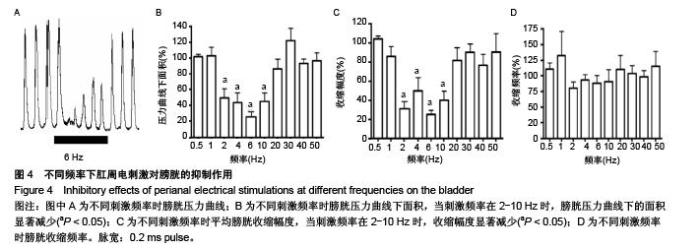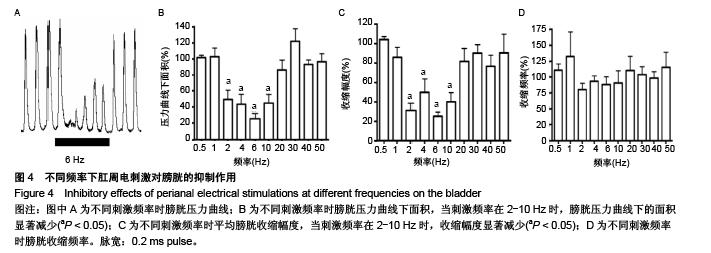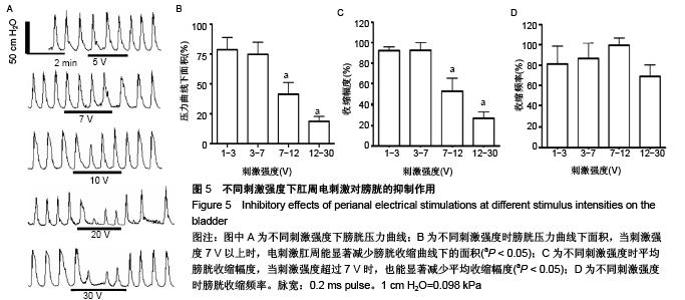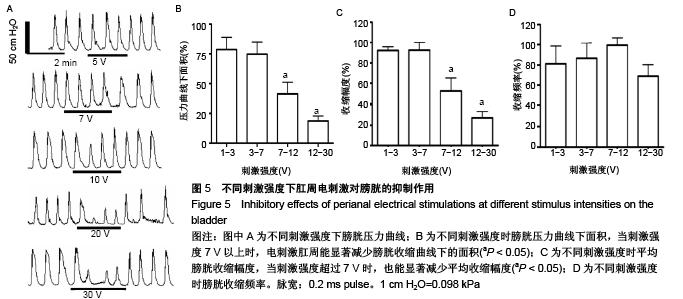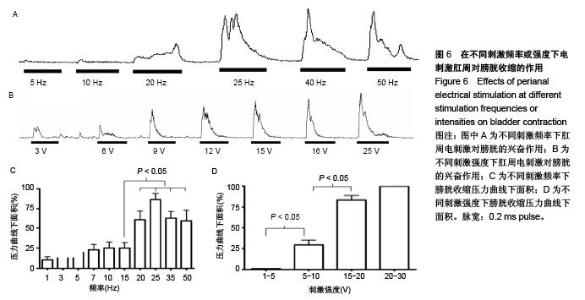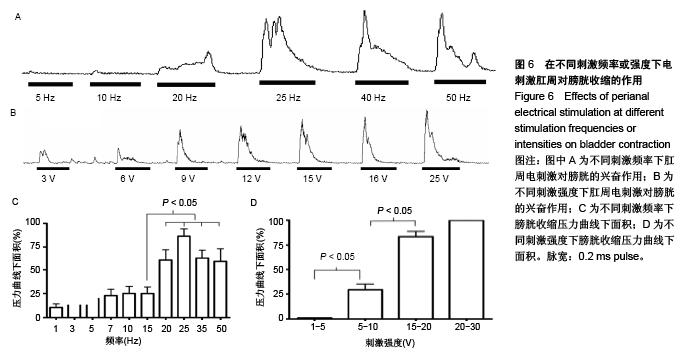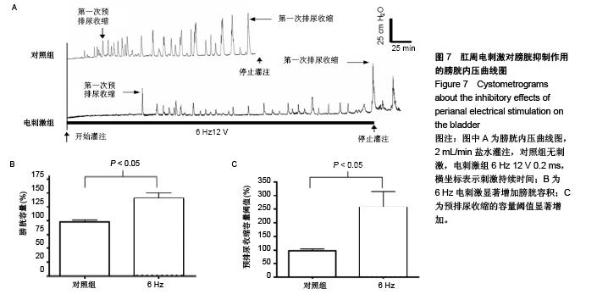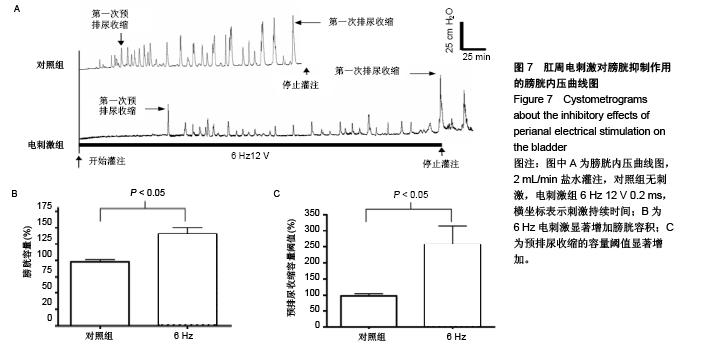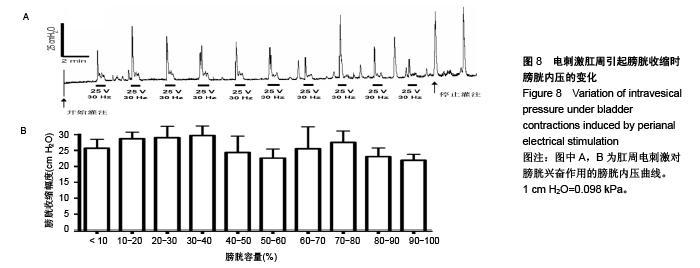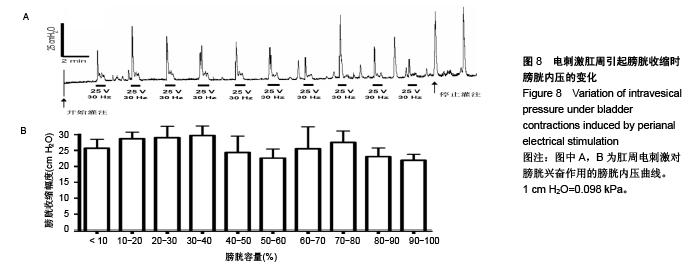Chinese Journal of Tissue Engineering Research ›› 2015, Vol. 19 ›› Issue (49): 7932-7937.doi: 10.3969/j.issn.2095-4344.2015.49.011
Previous Articles Next Articles
Electrical stimulation of the perianal skin regulates neurogenic intravesical pressure in rabbit models of spinal cord injury
Yan Peng1, Zheng Wei-dong1, Tan Yun-bing1, Deng Xiao-ming1, Yang Xiao-yu2
- 1Department of Spinal Surgery, Jilin Province People’s Hospital, Changchun 130000, Jilin Province, China; 2Bethune Second Hospital of Jilin University, Changchun 130000, Jilin Province, China
-
Received:2015-09-05Online:2015-11-30Published:2015-11-30 -
Contact:Yang Xiao-yu, M.D., Chief physician, Bethune Second Hospital of Jilin University, Changchun 130000, Jilin Province, China -
About author:Yan Peng, M.D., Attending physician, Department of Spinal Surgery, Jilin Province People’s Hospital, Changchun 130000, Jilin Province, China -
Supported by:a grant from Jilin Province Science and Technology Commission International Cooperation Projects of China, No. 20100735
CLC Number:
Cite this article
Yan Peng, Zheng Wei-dong, Tan Yun-bing, Deng Xiao-ming, Yang Xiao-yu. Electrical stimulation of the perianal skin regulates neurogenic intravesical pressure in rabbit models of spinal cord injury[J]. Chinese Journal of Tissue Engineering Research, 2015, 19(49): 7932-7937.
share this article
| [1] 闫鹏,杨小玉,高琦,等.神经假体移植与神经源性膀胱[J].中国组织工程研究与临床康复,2010,14(53):11026-11030. [2] Groen J, Amiel C, Bosch JL. Chronic pudendal nerve neuromodulation in women with idiopathic refractory detrusor overactivity incontinence: results of a pilot study with a novel minimally invasive implantable mini-stimulator. Neurourol Urodyn. 2005;24(3):226-230. [3] Reitz A, Schmid DM, Curt A, et al. Afferent fibers of the pudendal nerve modulate sympathetic neurons controlling the bladder neck. Neurourol Urodyn. 2003;22(6):597-601. [4] Hansen J, Media S, Nøhr M, et al. Treatment of neurogenic detrusor overactivity in spinal cord injured patients by conditional electrical stimulation. J Urol. 2005;173(6):2035-2039. [5] Kirkham AP, Knight SL, Craggs MD, et al. Neuromodulation through sacral nerve roots 2 to 4 with a Finetech-Brindley sacral posterior and anterior root stimulator. Spinal Cord. 2002;40(6):272-281. [6] 中华人民共和国科学技术部. 关于善待实验动物的指导性意见. 2006-09-30. [7] Wein AJ, Kavoussi LR, Campbell MF.坎贝尔-沃尔什泌尿外科学(第三卷)[M]. 郭应禄,周利群译.北京:北京大学医学出版社,2009:2138. [8] Fehlings MG, Tator CH. The relationships among the severity of spinal cord injury, residual neurological function, axon counts, and counts of retrogradely labeled neurons after experimental spinal cord injury. Exp Neurol. 1995;132(2):220-228. [9] Sasatomi K, Hiragata S, Miyazato M, et al. Nitric oxide-mediated suppression of detrusor overactivity by arginase inhibitor in rats with chronic spinal cord injury. Urology. 2008;72(3):696-700. [10] Thor KB, Roppolo JR, deGroat WC. Naloxone induced micturition in unanesthetized paraplegic cats. J Urol. 1983;129(1):202-205. [11] Godec C, Cass AS, Ayala GF. Bladder inhibition with functional electrical stimulation. Urology. 1975;6(6):663-666. [12] Godec C, Cass AS, Ayala GF. Electrical stimulation for incontinence. Technique, selection, and results. Urology. 1976;7(4):388-397. [13] Rodriquez AA, Awad E. Detrusor muscle and sphincteric response to anorectal stimulation in spinal cord injury. Arch Phys Med Rehabil. 1979;60(6):269-272. [14] Rossier A, Bors E. Detrusor responses to perianal and rectal stimulation in patients with spinal cord injuries. Urol Int 1964; 18:181-190. [15] Martin WD, Fletcher TF, Bradley WE. Innervation of feline perineal musculature. Anat Rec. 1974;180(1):15-29. [16] Fall M, Lindström S. Electrical stimulation. A physiologic approach to the treatment of urinary incontinence. Urol Clin North Am. 1991;18(2):393-407. [17] Tai C, Smerin SE, de Groat WC, et al. Pudendal-to-bladder reflex in chronic spinal-cord-injured cats. Exp Neurol. 2006; 197(1):225-234. [18] Yan P, Yang XY, Gao Q, et al. Electrical stimulation of the sacral nerve anterior root following induced bladder detrusor contraction. Neural Regen Res. 2010;5(24):1900-1904. [19] Wang XR. Long-term anodal block stimulation at sacral anterior roots promoted recovery of neurogenic bladder function in a rabbit model of complete spinal cord injury. Neural Regen Res. 2012;7(5):352-358. |
| [1] | Chen Ziyang, Pu Rui, Deng Shuang, Yuan Lingyan. Regulatory effect of exosomes on exercise-mediated insulin resistance diseases [J]. Chinese Journal of Tissue Engineering Research, 2021, 25(25): 4089-4094. |
| [2] | Chen Yang, Huang Denggao, Gao Yuanhui, Wang Shunlan, Cao Hui, Zheng Linlin, He Haowei, Luo Siqin, Xiao Jingchuan, Zhang Yingai, Zhang Shufang. Low-intensity pulsed ultrasound promotes the proliferation and adhesion of human adipose-derived mesenchymal stem cells [J]. Chinese Journal of Tissue Engineering Research, 2021, 25(25): 3949-3955. |
| [3] | Yang Junhui, Luo Jinli, Yuan Xiaoping. Effects of human growth hormone on proliferation and osteogenic differentiation of human periodontal ligament stem cells [J]. Chinese Journal of Tissue Engineering Research, 2021, 25(25): 3956-3961. |
| [4] | Sun Jianwei, Yang Xinming, Zhang Ying. Effect of montelukast combined with bone marrow mesenchymal stem cell transplantation on spinal cord injury in rat models [J]. Chinese Journal of Tissue Engineering Research, 2021, 25(25): 3962-3969. |
| [5] | Gao Shan, Huang Dongjing, Hong Haiman, Jia Jingqiao, Meng Fei. Comparison on the curative effect of human placenta-derived mesenchymal stem cells and induced islet-like cells in gestational diabetes mellitus rats [J]. Chinese Journal of Tissue Engineering Research, 2021, 25(25): 3981-3987. |
| [6] | Hao Xiaona, Zhang Yingjie, Li Yuyun, Xu Tao. Bone marrow mesenchymal stem cells overexpressing prolyl oligopeptidase on the repair of liver fibrosis in rat models [J]. Chinese Journal of Tissue Engineering Research, 2021, 25(25): 3988-3993. |
| [7] | Liu Jianyou, Jia Zhongwei, Niu Jiawei, Cao Xinjie, Zhang Dong, Wei Jie. A new method for measuring the anteversion angle of the femoral neck by constructing the three-dimensional digital model of the femur [J]. Chinese Journal of Tissue Engineering Research, 2021, 25(24): 3779-3783. |
| [8] | Meng Lingjie, Qian Hui, Sheng Xiaolei, Lu Jianfeng, Huang Jianping, Qi Liangang, Liu Zongbao. Application of three-dimensional printing technology combined with bone cement in minimally invasive treatment of the collapsed Sanders III type of calcaneal fractures [J]. Chinese Journal of Tissue Engineering Research, 2021, 25(24): 3784-3789. |
| [9] | Qian Xuankun, Huang Hefei, Wu Chengcong, Liu Keting, Ou Hua, Zhang Jinpeng, Ren Jing, Wan Jianshan. Computer-assisted navigation combined with minimally invasive transforaminal lumbar interbody fusion for lumbar spondylolisthesis [J]. Chinese Journal of Tissue Engineering Research, 2021, 25(24): 3790-3795. |
| [10] | Hu Jing, Xiang Yang, Ye Chuan, Han Ziji. Three-dimensional printing assisted screw placement and freehand pedicle screw fixation in the treatment of thoracolumbar fractures: 1-year follow-up [J]. Chinese Journal of Tissue Engineering Research, 2021, 25(24): 3804-3809. |
| [11] | Shu Qihang, Liao Yijia, Xue Jingbo, Yan Yiguo, Wang Cheng. Three-dimensional finite element analysis of a new three-dimensional printed porous fusion cage for cervical vertebra [J]. Chinese Journal of Tissue Engineering Research, 2021, 25(24): 3810-3815. |
| [12] | Wang Yihan, Li Yang, Zhang Ling, Zhang Rui, Xu Ruida, Han Xiaofeng, Cheng Guangqi, Wang Weil. Application of three-dimensional visualization technology for digital orthopedics in the reduction and fixation of intertrochanteric fracture [J]. Chinese Journal of Tissue Engineering Research, 2021, 25(24): 3816-3820. |
| [13] | Sun Maji, Wang Qiuan, Zhang Xingchen, Guo Chong, Yuan Feng, Guo Kaijin. Development and biomechanical analysis of a new anterior cervical pedicle screw fixation system [J]. Chinese Journal of Tissue Engineering Research, 2021, 25(24): 3821-3825. |
| [14] | Lin Wang, Wang Yingying, Guo Weizhong, Yuan Cuihua, Xu Shenggui, Zhang Shenshen, Lin Chengshou. Adopting expanded lateral approach to enhance the mechanical stability and knee function for treating posterolateral column fracture of tibial plateau [J]. Chinese Journal of Tissue Engineering Research, 2021, 25(24): 3826-3827. |
| [15] | Zhu Yun, Chen Yu, Qiu Hao, Liu Dun, Jin Guorong, Chen Shimou, Weng Zheng. Finite element analysis for treatment of osteoporotic femoral fracture with far cortical locking screw [J]. Chinese Journal of Tissue Engineering Research, 2021, 25(24): 3832-3837. |
| Viewed | ||||||
|
Full text |
|
|||||
|
Abstract |
|
|||||
